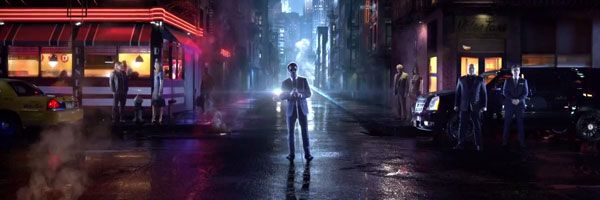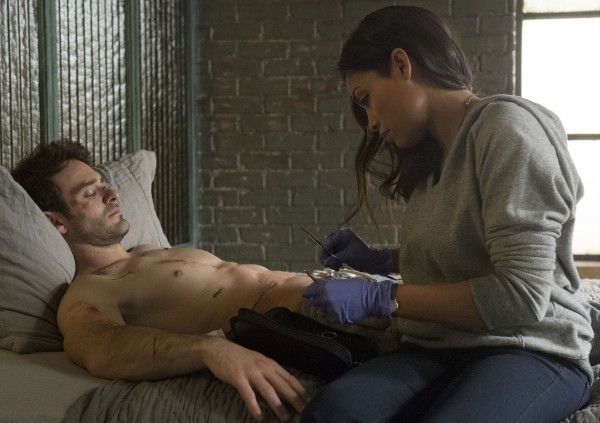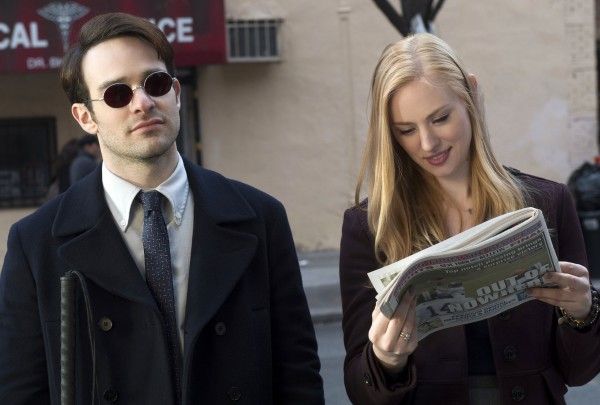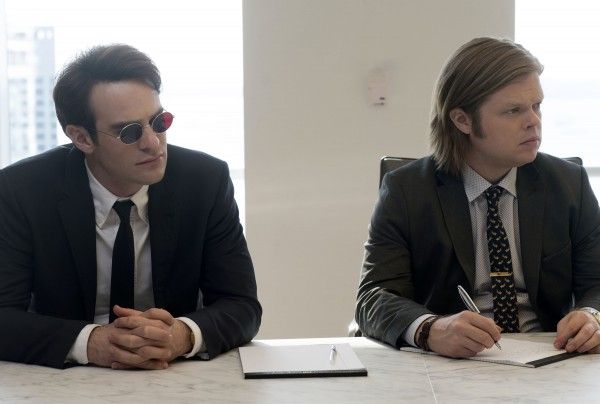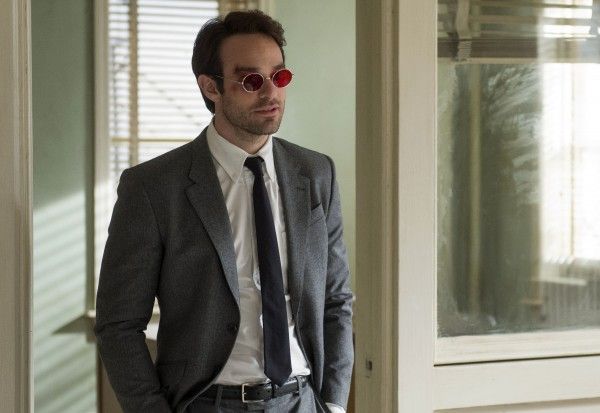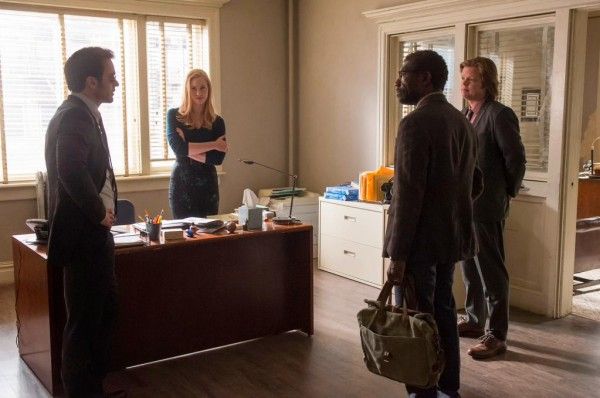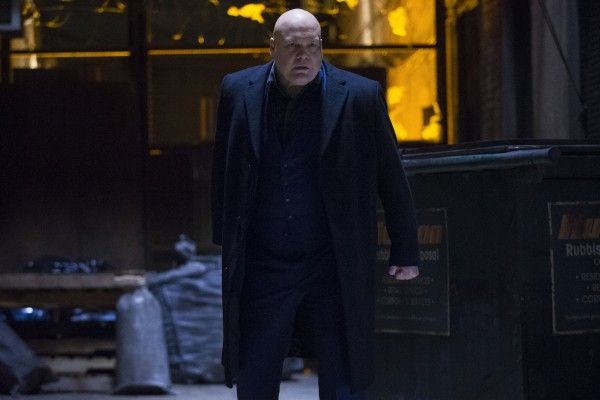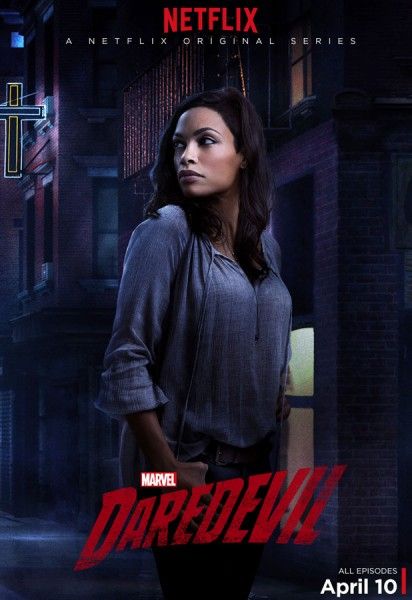Marvel’s Daredevil, available at Netflix on April 10th, is the dark, gritty tale of Matt Murdock (Charlie Cox), a man blinded as a young boy but also imbued with extraordinary senses, who fights against injustice by day as a lawyer, and then protects the streets of Hell’s Kitchen, New York by night as the superhero Daredevil. It simultaneously delves into the backstory of the character’s evolution while also starting down the path of an eventual teaming up with Jessica Jones, Iron Fist and Luke Cage for The Defenders.
At the show’s press day, co-stars Charlie Cox (“Matt Murdock” / “Daredevil”) talked about the creative challenges of getting into this character, that he didn’t grow up on comics, how his first exposure to the character was in the first two scripts for the series, that viewers will get to see the evolution of Daredevil, and approaching these challenging fight scenes, while Rosario Dawson (“Claire Temple”) talked about being a fan of the street-level characters, the appeal of this character for her, and why she thinks it’s an important element that Claire speaks Spanish. Be aware that there are some spoilers.
Question: Charlie, what were the creative challenges of getting into this character?
CHARLIE COX: It feels like it was many fold. There were so many aspects to it. The obvious one that jumps to mind is the blindness, and everything that comes with that. It was important to me that there was a real consistency around how Matt and Daredevil operate. So for example, when Matt’s out in the public, he has to maintain the illusion that he operates like a regular blind person. However, when he’s on his own, or when he’s with people who maybe know about him, he can operate better than a seeing person, so he wouldn’t need his cane, per se, and he wouldn’t need to feel for things on the table. So, finding out what that felt like and what that looked like was one challenge. And then, there’s also the difficulty of the eyes themselves and what they do. When he’s not wearing his mask, he’s wearing his glasses, so what are his eyes doing and what would that look like? I worked very closely with a wonderful gentleman, called Joe Strechay, who’s been legally blind for 20 years. I spent a lot of time working with him on my cane technique and household chores, and things like that. But also, I filmed him talking to me and filmed his eyes, in particular, and what they were doing. So, the blindness was one area that I concentrated on a lot. There’s also the physical aspects of the role, with the martial arts and the training, and I just did as much of that as I was allowed to do. I really enjoy that aspect of filmmaking. I really relish the opportunity to do it, and fight sequences come to me quite quickly. I can pick them up relatively quickly, so that’s a bonus. And then, the third thing worth mentioning was reading a ton of Daredevil comics.
Were you a fan before this?
COX: I was not, no. I didn’t grow up on comics, and I read very few. I hadn’t read any Daredevil comics, which I know now is a shame. Actually, in some ways, it served me quite well because the first anything Daredevil that I was subjected to were the first two scripts by Drew Goddard. In a way, it was quite helpful because I was then able to go from having read the scripts to the comics, and I was able to identify series and artists and writers that best suited the show that I read. I didn’t have too many preconceived ideas about who I thought the character should be, or what the show should be like. I was able to just isolate the comics that best suited the show that I read, and focus in on those ones.
Rosario, was Daredevil something you were always a fan of?
ROSARIO DAWSON: Yeah, I very much like Daredevil. I like the street-level characters. I like that idea of someone who goes out there and pushes themselves to greatness. That’s the world that we live in right now. We have police officers and firemen, so we tend to be like, “I’m not going to run into that burning building. I’m not even going to call 911. Someone else will.” We have that thing of passing it on. So, I’ve always been particularly fascinated with the Daredevil-type characters who go, “No, I can do something to help. It’s not always going to be comfortable, it’s going to put me at risk, and I’m going to make my whole world vulnerable for it, but I can do something here. I can’t not. I can’t un-know something that I already know.” Batman puts on a Batsuit and fights petty crime when he’s a billionaire. A person who has everything that we all are supposed to aspire to says, “No, what I really want do is this. Vigilante justice is this space that I know I can really make a difference.” To me, that is just so compelling. And the fact that we get to explore those characters in depth, all throughout these different series that Marvel is doing with Netflix, is very exciting. I think it puts a different onus on the viewer to not just look at it like entertainment, but maybe be a little bit compelled and persuaded and inspired to step up their game a little bit and be the hero that they can be.
Charlie, in this show, you carry a great confidence as Matt Murdock. Whenever he enters the room, he lets everyone know that he’s in charge. Did you enjoy getting to perform that aspect of the character?
COX: That’s a really interesting question. The honest answer is that I’m not quite sure how that came about. I think it’s very evident in the panels of the comics. There’s often a lot of motion to Foggy and to some of the other characters, and Matt’s often very, very still. The only other thing that I was aware of was the idea that there’s a sensory overload going on with Matt Murdock. He’s receiving so much information, and what might that do to a person is just keep them very centered and very still, as they take it all in? It might be that that confidence is more of a by-product of what he’s dealing with, how he’s living his life, and what he’s feeling and sensing, on a daily basis. But I think there’s definitely something to be said for the kind of person who has command of a room, whether they can see the individuals in it or not.
Is there a distinction you can make, as to whether Matt Murdock becomes Daredevil, or Daredevil has to pretend to be Matt Murdock?
COX: I so don’t want to want to answer that question. Really, the mask that Matt Murdock puts on is when he doesn’t have his mask on. It’s when he’s walking on the streets as a lawyer and maintaining this illusion that he would need a cane, or that he would need to feel for things on the table to find them. In our show, what we’re seeing is the evolution of Matt Murdock into Daredevil. We’ve got these 13 episodes to plot that very, very slowly and carefully. It’s like a pendulum that swings. In some ways, the Daredevil that we will come to know and love, hopefully, by the end of the show and by seasons to come, is who he is innately. That’s who he is and who he’s always been, since the accident. He will embody and fully realize who he is as Daredevil. But at this point, in the beginning of the show, he’s still having to find his way with that, so it’s almost like it starts the other way around. It starts with Matt Murdock, and the alter ego is Daredevil.
Your character doesn’t come in with a lot of comic book baggage, as this is a fresh reinvention. What was the appeal of Claire Temple, for you?
DAWSON: People know that Marvel is doing something fun, which is what we get to do when you have a whole universe that you can play with. We can change things and massage things and develop things. For me, that gets me really excited because I love the question mark that’s on there. There are a lot of people going, “Wait a minute, that character was married to Luke Cage. What does that mean? But wait, that character was Night Nurse, so what does that mean?” All of that delights me. It’s so fun. I’ve never really done television before, so to be in this experience, a couple of episodes in and I’m finally finding out my character is going to make this detour, I’m like, “Oh, okay, that’s cool.” I couldn’t have just looked at that in the comic, or in some old film. We’re reinterpreting these characters and this world, and for someone, like myself, who loves comics and has been wanting to be a part of the Marvel universe for a very long time, it’s really cool to go in, in this way. I think it’s exceptional and special and awesome and perfect.
Claire and Matt seem to trust each other, right away. Where do you think that trust really comes from, especially for these two people who don’t really trust a lot of people?
COX: Well, Matt knows that she’s telling the truth from the questions that he asks her. She tells him who she is, and she’s not lying. He can tell, by the nature in which she talks to him, that her intentions are strong and good. So for him, it’s easy to trust her.
DAWSON: He’s also forced to have to. This is a situation where he wasn’t his full self. When the heat is on, your true self is going to show up. What’s really interesting is that, meeting under any or other normal circumstances, they would have behaved very differently, but the circumstances dictated that they would actually be their inner selves, which showed them each other’s values. At the end of the day, despite Claire’s own risk, she’s going to care for someone else and put that first. She’s going to be really present, and she knows that this choice could equal something really potentially dangerous, down the line. But in this moment, what’s most important is that, if she doesn’t step in right now, someone is going to die, and she can actually do something about it. The fact that there are those types of people who rise to that type of occasion, automatically, it puts them at a different level of taking each other in than normal folks. They automatically get to leap frog into a relationship that should have taken a much longer time to develop, and I think they’re both very pleasantly surprised at the character that the other shows. Their instinct told them that it was okay. And as you see them develop with each other, you see them get more and more comfortable with going, “Okay, I can actually truly be myself, and you can truly be yourself. That’s actually special because there is no one else, I can be this way with.” So, it was necessary, but it becomes very special.
Rosario, was it important to you that Claire speak Spanish?
DAWSON: When I first read it, it was in Spanish, and I thought it was really great. It feels like New York to me. It’s definitely one of those things where you have a diverse character who’s speaking Spanish. It’s New York. It would be weird if someone didn’t speak another language, at some point. You’re going to hear different accents. You’re going to come across different cultures, and people with different backgrounds. The fact that people are speaking Spanish to each other makes sense to me. You graduate into a different sphere just by taking those allowances, and I like that. I like that it didn’t feel like anything other than making sure that we were being really realistic about our portrayal of these characters in New York, in this moment.
These fight scenes are pretty incredible, and some of them are really relentlessly intense. Was there any one, in particular, that was really complicated for you and that took the longest?
COX: Well, the way that we did it was that I worked very closely with the stunt coordinator and my stunt double, and I would break up the fight sequences into about six to ten movies, at a time, that I could learn. It really depended on how complicated those movements were and, of course, the other actor. The great thing is that we always found the time to rehearse, and make sure it was a safe space, and that both actors, or the actor and the stunt double, felt safe within the moves. And then, it’s a bit like fast-forwarding a tape. You start doing it in slow motion, and then you get quicker and quicker and quicker. It’s a real collaborative process because you’re not actually hitting people and it’s looking like you are. So, it’s not just about throwing a punch. It’s about selling a punch. It’s also about the lighting and the camera angle covering it in a way that it looks like it’s a real hit to the face, or whatever.
DAWSON: It’s really complicated, as they move around. There’s a certain way that you can sell that punch, if the camera was here. But if they fight and move, then the camera has got to move. Everybody is part of that choreography and dance. It’s really remarkable when you see it happen. When everyone is working together like that, you hear a cheer that comes from every single person in the whole production.
COX: You can have the most emotional moment as an actor, ever, and many people would be like, “Okay, cool. What’s next?” You land one punch in a fight scene, and everyone is like, “Yeah!”
Marvel's Daredevil is available at Netflix on April 10th.

